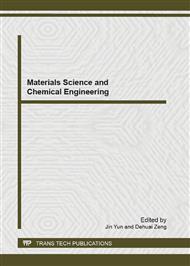[1]
H. Molisch , Der Einfluss einer Pflanze auf die andere-Allelopathie, Fischer, Jena. 1937.
DOI: 10.1038/141493a0
Google Scholar
[2]
E.L. Rice , Allelopathy. Academic Press Inc. The University of Okalahoma. Norman Oklahoma. 1984.
Google Scholar
[3]
U.M. Azim, "Allelopathy: Advances, Challenges and Opportunities," Allelopathy in sustainable agriculture and forestry, pp.25-38, 2008.
DOI: 10.1007/978-0-387-77337-7_2
Google Scholar
[4]
W. Susanne and S. Beersum, "The impact of soil organism composition and activated carbon on grass-legume competition," Plant and Soil, vol. 314, no. 1-2 , pp.1-9, 2009.
DOI: 10.1007/s11104-008-9618-0
Google Scholar
[5]
A. Sanon, Z.N. Andrianjaka and Y. Prin , "Rhizosphere microbiota interfers with plant-plant interactions," Plant and Soil, vol. 321, no. 1-2, pp.259-278, 2009.
DOI: 10.1007/s11104-009-0010-5
Google Scholar
[6]
B. Gooden, K. French and P.J. Turner, "Invasion and management of a woody plant, Lantana camara L., alters vegetation diversity within wet sclerophyll forest in southeastern Australia," Forest Ecology and Management, vol. 257, no. 3, 960-967, 2009.
DOI: 10.1016/j.foreco.2008.10.040
Google Scholar
[7]
S. Małgorzata and K. Paweł, "The Stratiotes aloides L. stand as a habitat in oxbow lake Bużysko," Aquatic Botany, vol. 90, no. 1, pp.1-6, 2009.
DOI: 10.1016/j.aquabot.2008.04.010
Google Scholar
[8]
Q. Wang, S.Q. Jing and X. Ruan , "Ecological explanations for successful invasion of exotic plants," Frontiers of Biology in China, vol. 4, no. 3, pp.271-281, 2008.
DOI: 10.1007/s11515-009-0032-7
Google Scholar
[9]
H.G. Baker, "Characteristics and modes of origin of weeds," in The genetics of colonizing species, Academic Press, London, vol. 23, pp.147-72, 1965.
Google Scholar
[10]
C.S. Elton, The Ecology of Invasion by Animals and Plants. London: Chapman and Hall, 1958.
Google Scholar
[11]
Darwin, The Origin of Species by Means of Natural Selection. 1859.
Google Scholar
[12]
M.J. Crawley, "What makes a community invasible," in Blackwell Scientific, London. pp.429-453, 1987.
Google Scholar
[13]
K. Shea and P. Chesson, "Community ecology theory as a framework for biological invasions," Trends in Ecology and Evolution, vol. 17, no. 4, pp.170-176, 2002.
DOI: 10.1016/s0169-5347(02)02495-3
Google Scholar
[14]
A.U. Mallick, "Effects of Vaccinium myrtillus on spruce regeneration: testing the notion of coevolutionary significance of allelopathy," Jounrnal of Chemical Ecology, vol. 26, no. 9, pp.2197-2209, 2000.
Google Scholar
[15]
R.M. Callaway and W.M. Ridenour, "Novel weapons: invasive success and the evolution of increased competitive ability," Frontiers in Ecology and the Environment, vol. 2 no.8, pp.436-443, 2004.
DOI: 10.1890/1540-9295(2004)002[0436:nwisat]2.0.co;2
Google Scholar
[16]
R.F. Fischer, R.A. Woods and M.R. Glavicic, "Allelopathic effects of goldenrod and aster on young sugar maple," Canadian Journal of Forest Research, vol. 8, no. 1, pp.1-9, 1978.
DOI: 10.1139/x78-001
Google Scholar
[17]
K.N. Hisashi, "Allelopathic substance in rice toot exudates: rediscovery of momilaetone B as an allelochemical," Journal of Plant Physiology, vol. 161,no. 3, pp.271-276, 2004.
DOI: 10.1078/0176-1617-01188
Google Scholar
[18]
R.Y. Yang, L.Y. Mei and J.J. Tanf, "Allelopathic effects of invasive Solidago Canadensis L. on germination and growth of native Chinese plant species," Allelopathy Journal, vol. 19, no. 1, pp.241-247, 2007.
Google Scholar
[19]
L. Djurdjevic, A. Dinic and P. Pavlovic, "Allelopathic potential of Allium ursinum L," Biochemical Systematics and Ecology, vol. 32, no. 6, pp.533-544, 2004.
DOI: 10.1016/j.bse.2003.10.001
Google Scholar
[20]
J.M. Bradow and W.J. Connick, "Volatile seed-germination inhibitors from plant residues," Journal of Chemical Ecology, vol. 16, no. 3, pp.645-666, 1990.
DOI: 10.1007/bf01016477
Google Scholar
[21]
H.P. Bais, R. Vepachedu and S. Gilroy, "Allelopathy and exotic plant invasion: from molecules and genes to species interactions," Science, vol. 301, no. 5638, pp.1377-1380, 2003.
DOI: 10.1126/science.1083245
Google Scholar
[22]
K. Kobayashi , H. Koyama and I.S. Shim, "Relationship between behavior of dehydromatricaria ester in soil and the allopathic activity of Solidago altissima L. in the laboratory," Plant and Soil, vol. 259, no.1-2, pp.97-102, 2004.
DOI: 10.1023/b:plso.0000020943.42226.a3
Google Scholar
[23]
Inderjit, "Soil microorganisms: an important determinant of allelopathic activity," Plant and Soil, vol. 274,pp.227-236, 2005.
DOI: 10.1007/s11104-004-0159-x
Google Scholar
[24]
A.P. Norton, A.C. Blair and J.G. Hardin, "Herbivory and novel weapons: no evidence for enhanced competitive ability or allelopathy induction of Centaurea diffusa by biological controls," Biological Invasions, vol. 10, no. 1, pp.79-88, 2008.
DOI: 10.1007/s10530-007-9111-3
Google Scholar


